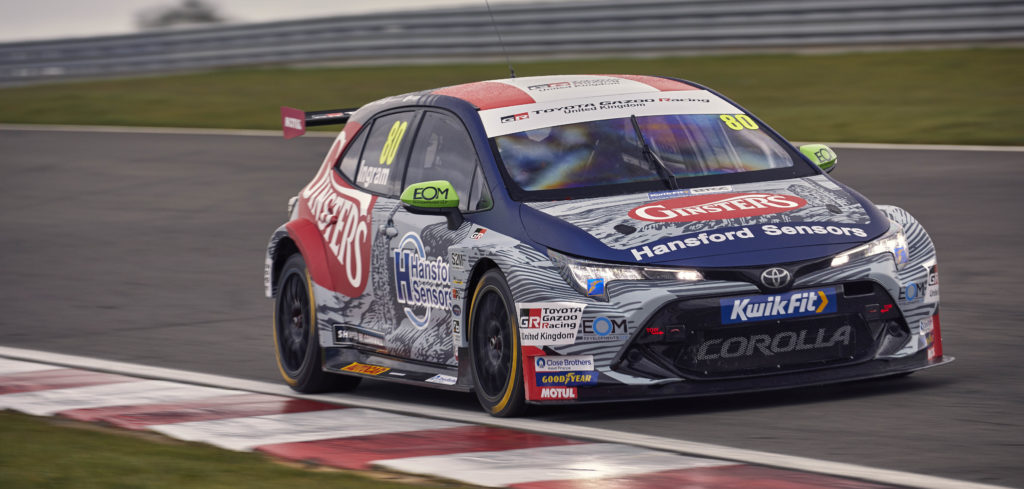D2H Advanced Technologies has been chosen to work with the Toyota Gazoo Racing UK team, providing the outfit with computational fluid dynamics (CFD) modeling.
With this support, the aerodynamic performance of the British Touring Car Championship (BTCC) team’s Corolla has been enhanced. The Corolla was a challenger for the lead in the second meeting of this year’s delayed season. Virtual analysis suggested the results have saved 0.75 seconds per lap for the BTCC car.
The manufacturer-backed team, run by Speedworks, approached D2H in December last year to help develop the Corolla after its inaugural season, where Tom Ingrams took it to sixth in the championship. Buckingham-based D2H, a company with experience in high quality CFD and aerodynamic analysis, started work in January this year with data from a vehicle scan, and completed bodywork was delivered, two days ahead of schedule, in mid-March.
“Speedworks knew there was significant potential for aero performance improvement after the 2019 season and approached us to undertake complete analysis, design and bodywork manufacture in a very short timeframe,” said Chris Hebert, D2H aerodynamics engineering director. “We used a combination of Ansys solver and in-house D2H software to boost resolution and shorten timescales. We’ve found our approach is highly effective, and it enabled us to deliver on time for Speedworks.”
Over the past few years, D2H has been challenging the perception of effective CFD being expensive and time-consuming when developing external aerodynamic performance. Hebert explained, “Unfortunately high resolution CFD is often seen as a very expensive option which can eat up time, whereas more affordable CFD alternatives are frequently unable to provide useful results. Our strategy from the start has been to develop methodologies and systems which enable high-quality CFD within tight deadlines.”
D2H has been using Ansys CFD software for a number of years. “We view Ansys as being the fastest, most accurate CFD solver on the market, while offering us the broadest options,” Hebert continued. “But this is only part of our strategy – we’ve also developed our own complementary software such as CAD-Check to give us control of the process while crucially enhancing both speed and quality of the analysis. Our high level of quality versus the cost of the process is at a ratio not seen elsewhere in the market, and routinely surprises new clients.”
D2H’s CAD-Check software rapidly checks CAD data for viability and ensures higher precision results and fewer downstream delays from CAD errors. Hebert said it’s been an important factor in delivering Speedworks’ bodywork on time: “Days of engineers’ time can be saved by deploying CAD-Check versus a more trial and error approach, and there’s no requirement for CFD engineering input – the process can be driven solely by aero engineers.”
Another key element in D2H’s strategy is the use of far larger mesh sizes which, in this case, are 20 times larger than those used by key rivals, according to the company. “Like a high resolution photograph, our use of increased mesh size gives us significant accuracy improvements. This enables us to analyze specific areas in greater detail, crucial when seeking incremental improvements in aerodynamic performance,” said Hebert.
“The end result for the Corolla is a 0.75-second reduction in average virtual lap times when tested over a number of UK circuits, which has translated into immediately improved race performance now that the delayed season is underway.”
The Corolla, again driven by Ingram, currently lies fourth in the championship after a strong second place at Brands Hatch.
The Speedworks team believes they chose the perfect aero partner. “D2H was able to offer us a combination of accurate CAD source data, high-quality CFD coupled to aero design, and an ability to manufacture the resulting bodywork design, all within a very tight timescale,” explained Christian Dick, team principal.
“This end-to-end process was the ideal solution for Speedworks, enabling us to advance the Corolla’s performance in advance of the 2020 season. The results speak for themselves, and we can’t wait to get it on track at the next meeting at Oulton Park!”
“CFD is an extremely valuable and cost-effective tool when it is used at high resolution in conjunction with relevant, time-saving systems,” concludes Hebert. “D2H’s strategy of using our own D2H processes and software combined with Ansys CFD has proved to be an extremely successful formula both in motorsport and wider automotive applications.”



